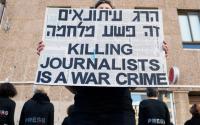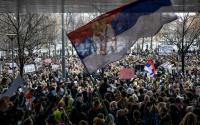27 December 2005Phyllis Bennis
The little town ofBethlehem isn't just still, it's dying.
On the eve of Christmas the Palestinian city is walled off, hemmed in, and virtually empty of tourists or visitors. Manger Square is barren, the few sad-looking Christmas stalls unfinished, souvenir shops bare of customers. The ancient road linking Bethlehem to Jerusalem, which is only two or three miles away, is blocked by Israel's so-called Separation Wall, whose 24-foot high concrete slabs virtually encircle the city.
The once-cosmopolitan and relatively wealthy people of Bethlehem are now isolated, increasingly impoverished, and imprisoned within a land area of only a few square kilometers. Many are leaving.
Media excitement is focusing on political changes inside Israel and the occupied Palestinian territories. Elections loom in both. In Israel, Ariel Sharon's abandonment of the right-wing Likud and his new "centrist" party caused shockwaves. The selection of a new trade union-based leader of the Labor Party raised hopes of potential changes. In the occupied territories, Hamas' decision to join the election process, challenges within the mainstream Fatah movement, and new independent slates of candidates, all raise interesting possibilities.
Some of these changes may bode well for some indeterminate time in the future. But for now, for ordinary Palestinians, life is getting harder.
Under the continuing Israeli occupation, Palestinians remain locked into tiny isolated cantons, unable to travel even between Palestinian cities because of Israeli checkpoints and closures.
Some towns, such as Qalquilya in the northern West Bank, are now completely cut off, physically surrounded by the Wall and dependent on the whim of Israeli soldiers who control the only two gates into the town.
Many Bethlehem residents have not been out of the Bethlehem-Beit Sahour-Beit Jala triangle for more than five years. Arab East Jerusalem, only a 10-minute drive away, remains out of reach. Israeli settlements are growing, in direct violation of international law and even of Israel's own commitments to the U.S.-sponsored "Road Map" that requires a complete freeze in settlement activity.
The Wall is growing larger and higher, grabbing more and more land on the Israeli side. It locks all of the West Bank's major aquifers onto the Israeli side, denying Palestinians access to their water sources. Israeli Justice Minister Tzipi Livni recently admitted the route of the Wall will be "significant" in shaping Israel's future borders. The Associated Press reports that it will "incorporate the major Jewish settlements and is seen as a de facto border."
The Wall divides the contiguous, water-rich Israeli territory of the West Bank, from the disconnected, parched Palestinian cantons that lie within it. These small Palestinian areas are separated by a matrix of settlements and Israeli-controlled roads and highways. It is almost inevitable Israel and the U.S. will soon anoint those truncated, non-contiguous bantustans as a Palestinian "state," however far they may be from a viable two-state solution.
Already the Israeli military checkpoint that blocks the road into Bethlehem has been transformed from a ramshackle set of sheds and barbed wire fences connected by muddy paths into a huge new automated complex abutting the Wall. Known as "the terminal," it features electronically-controlled floor-to-ceiling turnstiles and machine-gun-toting Israeli soldiers on prison-style catwalks above the heads of would-be tourists. In the words of one Jerusalem taxi driver stalled at the Bethlehem roadblock, "this isn't a checkpoint, it's an international border."
There is an international campaign, known as "Open Bethlehem," trying to revive the city's collapsing tourism industry. Go to http://www.openbethlehem.org/ for full information
But it faces insurmountable odds.
Bethlehem tourists no longer arrive on the "holy land" tours that once involved two or three-day stays at the town's numerous hotels. Now the few tourists that arrive are most likely to come on three-hour Israeli tour packages, direct from West Jerusalem. The buses clear the terminal and drive straight to Manger Square. Tourists alight smack in front of the Church of the Nativity. They enter the Church, look around, return to the bus and leave. They don't patronize the shops for souvenirs, they don't have time for a meal, they don't stay overnight in the hotels. They may not even speak to a single Palestinian.
The Palestinian economy and Bethlehem's tourism industry earn nothing.
So far the lights are still lit this year in Manger Square, the carolers will probably come out for a while. Bethlehem's Peace Center features a display of creches from around the world. But Bethlehem is dying. Monuments and ancient shrines may live forever, but living cities don't always survive generations of foreign occupation.
___________________
Phyllis Bennis is a fellow of the Institute for Policy Studies and author of CHALLENGING EMPIRE: How People, Governments and the UN Defy U.S. Power. She just returned from the occupied Palestinian territories.
War Times/Tiempo de Guerras is a fiscally sponsored project of the Center for Third World Organizing. Donations to War Times are tax-deductible; you can donate on-line at http://www.war-times.org or send a check to War Times/Tiempo de Guerras, c/o P.O. Box 99096, Emeryville, CA 94662.
http://www.zmag.org/content/showarticle.cfm?SectionID=107&ItemID=9410






